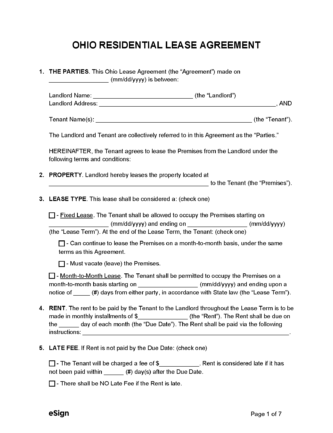
An Ohio lease agreement is a legally binding contract between a landlord and tenant for the rental of commercial or residential space. A rental contract is generally set for a one-year term, with rent being paid in monthly installments. In addition to the rental cost, the landlord may use the document to stipulate policies regarding pets, smoking, the security deposit, and late fees.
An Ohio lease agreement is a legally binding contract between a landlord and tenant for the rental of commercial or residential space. A rental contract is generally set for a one-year term, with rent being paid in monthly installments. In addition to the rental cost, the landlord may use the document to stipulate policies regarding pets, smoking, the security deposit, and late fees.
PDF Download
An Ohio lease agreement is a legally binding contract between a landlord and tenant for the rental of commercial or residential space. A rental contract is generally set for a one-year term, with rent being paid in monthly installments. In addition to the rental cost, the landlord may use the document to stipulate policies regarding pets, smoking, the security deposit, and late fees.
4.7 | 169 Ratings Downloads: 17,206
Rental Application – Potential tenants can be asked to fill out this form that asks for employment information and their rental history.
Maximum Amount ($) – No statute limits the amount of security deposit the landlord may charge.
Collecting Interest – If the security deposit is over $50 or 1 month’s rent, whichever is greater, the landlord must pay interest on the excess at a rate of 5% per year. This rule only applies to leases of at least 6 months. [3]
Returning to Tenant – The landlord must pay back the security deposit within 30 days of the lease termination date. [4]
Itemized List Required? – Yes, the landlord must provide the tenant with a written notice identifying the amount and the reason for any deductions from the security deposit. [5]
Separate Bank Account? – No, Ohio law does not require the security deposit to be kept in a separate account.
General Access – The landlord must give at least 24 hours’ notice before entering the tenant’s rental unit. [6]
Immediate Access – No notice is required before the landlord enters the rental unit in an emergency. [7]
Grace Period – Ohio law does not require a landlord to give a grace period for a late payment.
Maximum Late Fee ($) – There is no statutory limit on fees for late rental payments.
Bad Check (NSF) Fee – If a tenant’s check bounces, the landlord may charge a $30 fee or 10% of the check’s value, whichever is greater. [8]
Withholding Rent – If the landlord has failed to keep the property liveable and safe, the tenant must send a written notification giving them 30 days to fix the problem . The tenant may pay rent to the municipal court or request a rent reduction while the landlord remedies the issue. [9]
Non-Payment of Rent – notice to quit can be delivered to tenants who have failed to pay rent . [10]
Non-Compliance – The landlord may give the tenant a 3-day notice to quit if they breach a part of their lease. [11] A 30-day notice to quit may be sent to tenants, demanding they fix health and safety violations within that timeframe or be evicted. [12]
Lockouts – It is illegal for a landlord to lock the tenant out of their residence or attempt to force them out by terminating utilities or services. The only way to legally evict a tenant is with a court order. [13]
Leaving Before the End Date – If the tenant leaves before the lease ends, they will still be liable to pay the rent stated in the lease agreement unless a new tenant is found. The landlord must make reasonable efforts to find a new tenant. [14]
Month-to-Month Tenancy – A 30-day notice to quit informs a month-to-month tenant that the landlord will terminate their tenancy in 30 days. [15]
Unclaimed Property – No state laws dictate a landlord’s obligations when it comes to personal property left behind by a tenant.